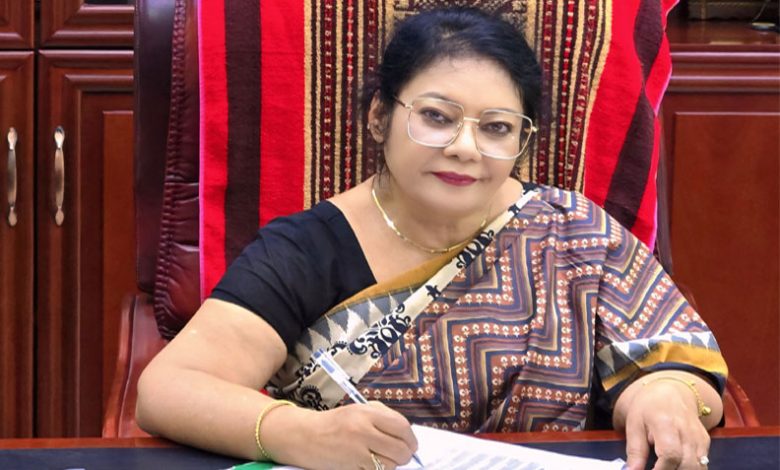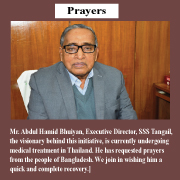PMK chief champions digital revolution in Bangladesh’s microfinance sector


Holiday Post Report: The leader of Palli Mongal Karmosuchi declares that embracing technology and expanding services beyond traditional credit will determine survival in the evolving financial landscape. She emphasizes that microfinance institutions must transform their operations immediately to remain competitive against digital banking platforms that threaten their client base.
Ms. Kamrun Nahar, Chief Executive of Palli Mongal Karmosuchi, commands attention when discussing Bangladesh’s future in microfinance. Her voice carries the authority of three decades spent navigating strategic planning, implementation, and partnership development across international and national organizations. She completed her M.Sc.in Psychology from Dhaka University in 1981 and undertook specialized training on microfinance product development in the Philippines and peace-building initiatives in Indonesia.
Ms. Nahar declares that Bangladesh’s microfinance sector maintains its pivotal role in financial inclusion, serving more than 40 million low-income individuals and microenterprises through licensed institutions nationwide. She cites data from the Microcredit Regulatory Authority showing 731 microfinance institutions operating under supervision as of June 2023, collectively running over 25,000 branches and employing more than 200,000 people nationwide.
The sector maintains an outstanding loan portfolio of Tk 2,493 billion while mobilized savings stand at Tk 621 billion, reflecting growing trust among grassroots borrowers and savers. She states that research indicates microfinance initiatives helped lift approximately 5 million people out of poverty between 2000 and 2020, particularly in rural areas.
Ms.Nahar warns that rising competition from digital financial platforms creates significant pressure points for traditional microfinance institutions. Agent banking, mobile financial services, and digital banks offer faster transactions and greater convenience, attracting younger, tech-savvy borrowers who previously relied on microfinance institutions. She observes that these technological disruptions demand immediate adaptation from established organizations.
NGOs face mounting difficulties securing loans from commercial banks, which now demand mortgage assets as collateral and 10 per cent to 15 per cent of savings from NGOs. She explains that banks offer loans at higher interest rates of 13 per cent to 14 per cent, while NGO loans remain regulated by the Microcredit Regulatory Authority. The demand for loans from NGOs increases, but banks prove unwilling to meet these needs, and securing loans from the Palli Karma-Sahayak Foundation (PKSF) becomes more challenging.
Technological adaptation presents another major hurdle for many microfinance institutions, particularly smaller ones still relying on manual processes. She emphasizes that regulatory compliance remains difficult, as smaller institutions struggle with reporting and transparency standards set by the Microcredit Regulatory Authority. In addition, she identifies maintaining financial sustainability while balancing social impact and operational viability as the most critical challenge facing institutions.
The Microcredit Regulatory Authority (MRA) has strengthened growth and public trust, but Ms. Nahar warns that some regulations now hinder innovation and growth, particularly for smaller microfinance institutions. While larger institutions possess the resources to comply with stringent rules, smaller organizations struggle with regulatory burden, limiting their ability to innovate or expand. She criticizes that current regulations fail to address technological adaptation needs or staff skill development requirements crucial for staying competitive.
Ms. Nahar calls for key policy adjustments to enhance sector growth and sustainability. She demands technical and financial assistance for microfinance institutions adopting new technologies, improving service delivery, and operational efficiency. A flexible regulatory framework that fosters innovation while ensuring accountability becomes crucial for maintaining adaptability and competitiveness. She insists that access to affordable funding through low-interest loans or grants remains vital for supporting financial sustainability and outreach efforts.
Bangladesh’s microfinance sector plays an increasingly vital role in advancing the United Nations’ Sustainable Development Goals (SDGs) and fostering social and economic progress. She explains that microfinance institutions promote financial inclusion by providing essential services to underserved communities, reducing poverty and inequality in line with SDG 1 and SDG 10. These institutions empower women entrepreneurs, contributing directly to SDG 5 by offering financial services that promote economic and social empowerment.
She emphasizes that microfinance institutions support small enterprises, stimulating local economies and creating jobs, thus advancing SDG 8. Some institutions integrate sustainable practices, helping promote SDG 13 by encouraging environmentally conscious initiatives supporting sustainable livelihoods. Ms. Nahar states that aligning services with national development plans, such as Bangladesh’s Vision 2041, enables institutions to contribute significantly to the country’s sustainable development trajectory.
To remain relevant in a rapidly changing financial landscape, microfinance institutions must embrace digital transformation, adopt client-centric models, and integrate sustainable finance practices. Nahar highlights that digital integration through platforms like bKash can significantly reduce operational costs while expanding outreach, especially in rural areas. Institutions need to diversify product offerings beyond providing credit, including services like micro-insurance, savings, and remittance solutions,to address broader client needs.
She stresses that, facing challenges such as climate change and economic shocks like the COVID-19 pandemic, institutions must build resilience by offering flexible repayment options, digital literacy programs, and establishing partnerships with fintech and agritech firms. Leveraging technology, data analytics, and cross-sector collaborations ensures financial inclusion, helping Bangladesh’s low-income populations navigate a dynamic economic environment.
Ms. Nahar describes her organization’s pursuit of building a prosperous, poverty-free, hunger-free, and exploitation-free Bangladesh through integrating sustainability and responsible lending into operations. The organization promotes sustainable development by supporting environment-friendly initiatives such as solar energy, organic farming, and clean water projects. Its lending programs link closely with broader social services, including education, health, and women’s empowerment, ensuring comprehensive poverty alleviation approaches.
She identifies several strategic approaches for achieving long-term sustainability and success. Digital transformation remains the top priority, focusing on embracing mobile banking, digital wallets, and fintech partnerships. These innovations reduce operational costs and expand client access, particularly in remote areas where traditional banking proves limited. Diversified financial services become essential, expanding offerings beyond credit to include savings accounts, micro-insurance, remittance services, and pension products.
Ms. Nahar emphasizes strengthening client protection and financial literacy through responsible lending practices and financial education initiatives, preventing over-indebtedness and ensuring effective loan utilization. Climate-resilient and green financing proves crucial, supporting eco-friendly businesses, renewable energy projects, and sustainable agriculture, contributing to long-term development while mitigating environmental challenges. Regulatory strengthening and transparency remain essential for maintaining accountability and financial stability.
She urges microfinance leaders to embrace innovation by investing in digital technologies like mobile banking and fintech partnerships to reduce costs and expand outreach. Leaders must strengthen social impact by integrating health, education, and climate resilience into services. Responsible lending practices and strategic partnerships with NGOs, government, and the private sector will amplify reach further. She declares that adaptive, empathetic leadership becomes key to creating long-term, inclusive development.
Throughout her years of engagement with Bangladesh’s microfinance sector, several pivotal moments shaped her perspective on its transformative role in poverty alleviation and economic empowerment. She identifies the founding of Grameen Bank in 1976 as one of the most defining milestones, introducing small, collateral-free loans, particularly for women, that challenged conventional banking models and demonstrated that even the poorest could break free from poverty when trusted with financial resources.
The Nobel Peace Prize awarded to Muhammad Yunus and Grameen Bank in 2006 represented another significant turning point, providing global recognition that underscored microfinance’s power as a tool for poverty reduction and financial inclusion. Nahar notes that the rise of mobile banking services like bKash revolutionized the sector in recent years, with digital platforms expanding financial access to remote and rural communities, making banking more inclusive and cost-effective.
She emphasizes that the COVID-19 pandemic proved the sector’s resilience, with microfinance institutions quickly adapting by offering flexible repayment plans and moving to digital platforms. The sector’s increasing focus on climate-resilient microfinance, such as financing green energy and micro-insurance for crops, highlights the growing intersection of economic and environmental sustainability in microfinance practices.




